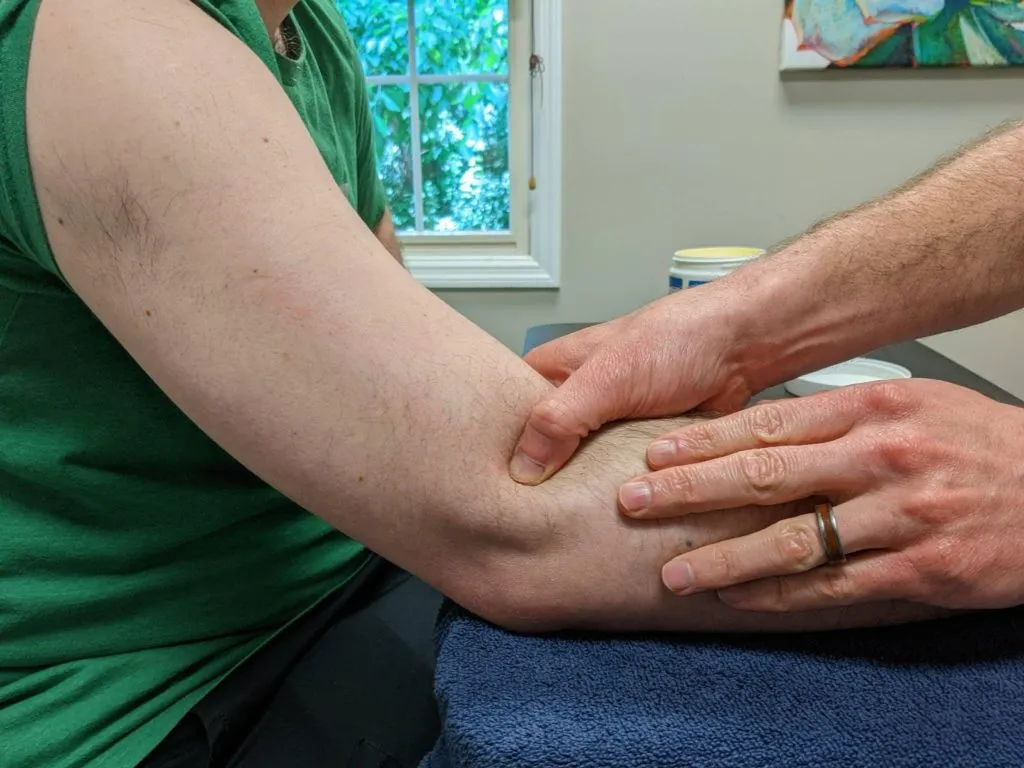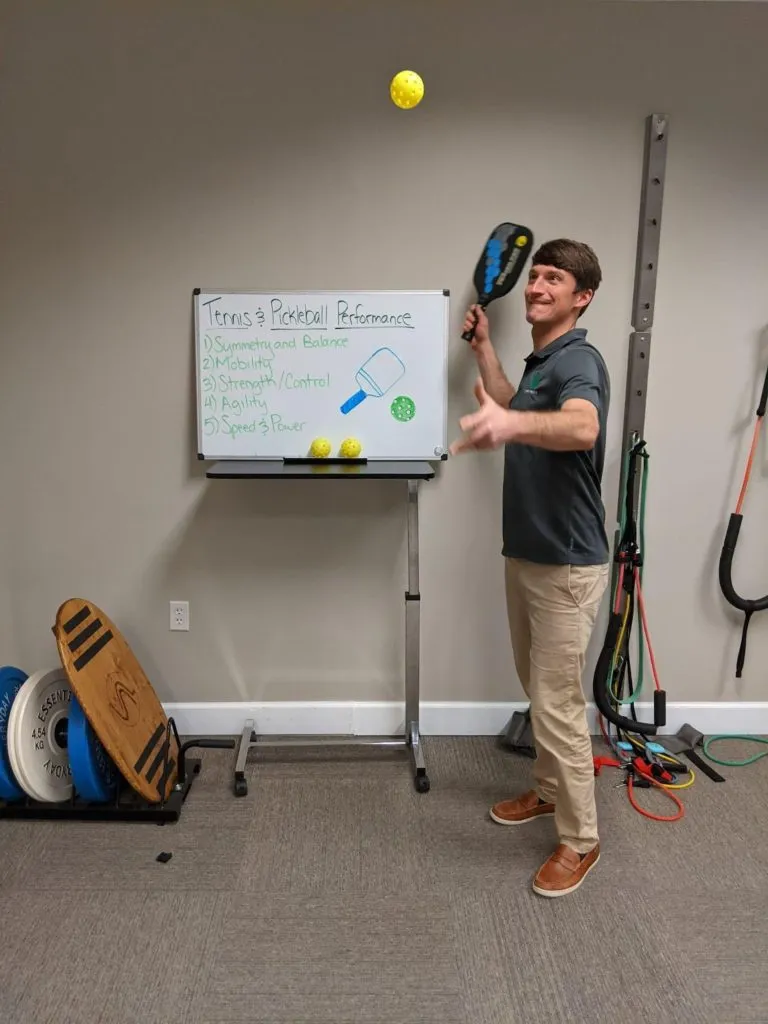Top Tips From A Physical Therapist to Ensure a Full Recovery.
Tennis and Pickleball Elbow can be quite frustrating. Pain can be severe and debilitating, and can really limit your daily activities. Not to mention your ability to function.
Sometimes you may even wonder if it will ever get better at all. This is a fair question, because a severe case of tennis elbow or pickleball elbow can take a very long time to get better, and in extreme cases, it can sometimes even take a year or longer.
If you are looking for an overnight fix, sadly, that is highly unlikely. To help heal the elbow, it’s usually somewhat of a process to work through.
Besides the natural healing process, there are other reasons that can prolong your recovery which I want to discuss in this article so that you can avoid them and set yourself up for healing as fast as possible.
Do I Even Have Tennis Elbow/Pickleball Elbow?

How do you know if you have tennis elbow or pickleball elbow? Here are the symptoms of most cases that we see:
- Pain will be primarily located on the lateral side of the elbow
- Tenderness to the touch, especially pressure along the muscle at the lateral elbow
- Pain with gripping
- Pain with twisting or bending your arm, or your elbow
- Stiffness or pain when extending your arm/ elbow
- Burning or pain that can go from your outer elbow and may travel to your wrist
- Swelling around the elbow or tenderness to the touch
- Reduced grip strength, noticed when gripping items such as a racket, a pen, or a doorknob
These listed above are all characteristics of tennis elbow or pickleball elbow, but are not a guarantee that you have a true case. Other injuries should be considered with a more stubborn or resistant case of lateral elbow pain. Alternate diagnoses include:
- muscle referral patterns
- trigger point referral from the deltoid or supraspinatus (which are part of your shoulder musculature)
- Cervical radiculopathy
- Radial Tunnel syndrome
- Cervical stenosis
- Golfers elbow
All of these conditions listed above will require other treatment strategies if not incorporated into your recovery plan and could be the missing piece or the complete reason why you aren’t responding to traditional tennis elbow or pickleball elbow recovery strategies.
How Long Does Tennis Elbow Or Pickleball Elbow Last?

The recovery time frame for tennis elbow or pickleball elbow is dependent on a number of factors. A more mild case can recover in a few weeks. Other cases can last for months or even years depending on how they are managed.
- The number one reason why pickleball elbow/tennis elbow lasts as long as it often time does is because someone ignores the pain and tries to work through it without taking any rest or activity modification.
This would mean continuing to play sports that are provoking your symptoms, such as tennis, pickleball, or doing activities that require a lot of forearm use, such as continuing to garden or repetitive gripping movements of the hand. Sometimes even working out, holding dumbbells & weights and pushing through the pain can continually cause the injury to get worse until the pain is at a point where it forces you to quit altogether.
2. A second reason why injury can last as long as it does is because somebody tries to get back to activities sooner than what their body is capable of due to their healing phase in recovery. For instance, someone might take a week off from playing their sport so the elbow starts feeling better and then when they resume playing, the pain is back and not much better. They rest for a short period of time and try to get back into the activities and this cycle can go on and on so that the elbow is never actually recovering, but continuing to have micro-injuries due to the excessive load.
3. The third reason tennis elbow/ pickleball elbow can last longer and not heal is excessive rest. I know this may sound contradictory compared to points number one and two, but avoidance of all activities and complete rest will result in an elbow, arm and tendon that gets more stiff and weak. When you eventually try to perform your activities, the tendon is incapable of withstanding stress and it still hurts. This can be really frustrating because you have taken excessive amounts of time off to rest and yet it feels like it hasn’t got much better.
The key part is understanding where you are in your healing process and when you need some level of rest and activity modification to allow the inflammation to calm down. Once this has happened, then we want to specifically and systematically start to work the elbow through flexibility and strength and exercises to regain back its ability to function and tolerate gripping and other exercises.
What Happens If Tennis Elbow Or Pickleball Elbow Goes Untreated?
With no treatment at all, most people will just avoid what hurts and this will lead to an overly stiff and weakened arm and tendon. You have to find the sweet spot of slowly working the arm and strengthening it without overworking it to the point of reinjury. Pain is a good indicator of how much you’re doing and if you are doing too much.
Excessive pain indicates that you’re likely causing some tissue trauma or micro-tears to the tendon that will continue feeding into the painful and injured state that we want to avoid.
The sweet spot is to be able to exercise and strengthen your arm without overly irritating it, after the inflammation cycle has calmed down. Once this has happened then getting into a gradual strengthening program without overdoing it is key.
Does Tennis Elbow Or Pickleball Elbow Ever Go Away?

Most people will ask this question multiple times because recovery can be quite frustrating. I’d encourage you to stay the course, stay consistent, and it can be very helpful to work with a professional who understands the healing process and the stages of recovery to help guide you.
The arm and tissue needs a specific amount of stimulus at a specific level to continue the healing process.
Most people will generally recover with time and with implementing these strategies, but I often see people with some residual symptoms or being prone to reinjury due to not sticking with the recovery plan or strengthening cycle in progressive loading of the tendon to a level that 100% heals the tendon.
When this happens, someone will typically get to a point where they don’t feel much pain at all in their daily activities, but if they start to push it with sports and more repetitive movements then their pain can start coming back.
This can be due to a number of factors such as improper mechanics or movement strategy, not the right equipment, or imbalances in other areas such as the upper back, shoulder or neck that should be improved on to take pressure off of the elbow.
What Movements Should I Avoid With Tennis Elbow Or Pickleball Elbow?
When you are in the acute very painful stage, you want to minimize repetitive gripping or hard gripping activities. If you remain idle with your elbow in a bent position, it can be very painful to straighten your arm back out a few times. It’s best to think about not having your arm in one position for too long, but a gentle range of motion and stretching exercises to the wrist and elbow to keep the condition from stiffening up too much.
Pain should be your guide and the goal is to never work through, or push yourself intentionally through, pain. One exception is when your elbow is bent, it is almost always going to be painful to straighten it back out. This is not because the straightening of your arm is the issue. The issue is more that you’ve left your arm in a bent position for too long and we need some slow, gradual movement to keep blood flow and movement around the joint free.
What If Tennis Elbow Or Pickleball Elbow Doesn’t Get Better?
It is very easy to get frustrated, and with a severe case, it’s likely you will do best working with a professional who can, first of all, make sure you haven’t misdiagnosed your injury. All tennis elbow and pickleball elbow injuries aren’t treated the same. Some will have to do more with the tendon and muscle, others will have some nerve involvement that requires some different types of exercises to help improve the nerve health as well. This can be harder to determine on your own.
When the muscle tendon gets really stiff or a lot of tension in the arm, having some hands on soft tissue work, massage, or dry needling can be very helpful for also knowing when you can apply other tools to relieve tension such as Kinesio tape or other braces can help guide you along through the healing process.
If you have tried some self-help videos, some periods of rest, or equipment modification, yet you still find yourself dealing with this injury, don’t take it personally. I just consider that you have a severe case and likely will need to consult with us or a health professional who regularly treats the condition to help find the missing pieces in your treatment plan.
We can help you get back to playing the sport you know and love.
How Long Does A Severe Tennis Elbow Or Pickleball Elbow Take To Heal?
With the right treatment approach and diagnosing all the contributing factors to your condition, your pain should start improving and seeing tangible improvements within a few weeks of treatment as long as you are not overdoing it and continuing to reinjure it.
It doesn’t mean a severe case will get better in a few weeks, as usually a severe case has already gone through some severity of tissue trauma and weakening. We find that it’s not uncommon for a severe case to take 6-12 months to get back to feeling 100%.
Dramatic improvement is usually seen within the first 1-2 months when managed correctly, but the final 20% improvement takes commitment to follow through on the treatment approach to restore back full health.
I find most people will get to feeling “pretty good” 80-90% better, or at least good enough to return back to most all activities including tennis and pickleball, but then they stop with their program. If your symptoms are still “hanging around” you likely need to continue developing your forearm strength and/ or check your form/ mechanics for your paddle or racquet swing.
Tennis elbow and pickleball elbow is an injury that needs to be taken seriously, otherwise you will pay the price with missed time on the court and a prolonged amount of time with aggravating pain.
In summary, if you have a stubborn case of tennis elbow or pickleball elbow, 1st make sure you have been correctly diagnosed. If your case has been confirmed, then you must stay consistent with your treatment of stretching and strengthening your forearm/ elbow while being mindful to not “over-do-it”.
Lastly, recognize that this condition does take some time to heal, and consult with an expert if your case is perplexing you so that your plan includes all elements needed to ensure a full and expedited recovery.



